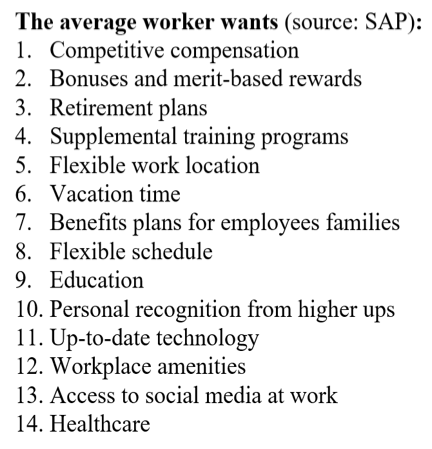They call it talent attraction for a reason. Because, obviously, the primary role of the function is to literally “attract” the very best candidates. But when a recruiting function is only guessing about what draws in desirable candidates, it will face a perennial shortage of applicants. In fact, I estimate that the average corporation loses up to 40 percent of its targeted candidates as a result of merely speculating about what factors effectively attract them.
The very best candidates are picky; they do insist on a firm meeting their attraction factors. And with the wrong factors, you end up losing many of the highest quality potential applicants. This means that your corporate careers/social media sites, recruitment ads, and your job postings will contain and emphasize the wrong attraction factors. And that will result in the attraction of the wrong or not enough people.
Identifying Attraction Factors Is Common In Corporate Marketing
Anyone who understands basic marketing 101 knows that you can’t attract your ideal targets without the right bait. Success at inbound marketing involves two steps: attraction and then conversion. The right attraction bait means “what are the factors that get the attention and then draw in your targets?”And of course, most already know that in corporate marketing on the business side, no one would ever attempt a new product marketing effort without first systematically identifying the customer-attraction factors. And after you know them, information about those attraction factors would be prominently displayed in any marketing or advertising effort. But surprisingly, in my research, I have found that it’s difficult to find a corporate recruiting function that has a formal process for accurately identifying these must-have job attraction factors in each of the segments of their recruiting targets.
Guessing About the Attraction Factors Has Disastrous Consequences
Most corporate recruiters simply assume that, as a result of many conversations that they have with candidates, they already know what the correct attraction factors are. And that’s the problem. As I cited earlier, when corporate recruiting simply assumes that they know the factors, they usually get them wrong. It is easy to test the accuracy of a recruiter or a hiring manager’s guessing attempts, by simply asking a candidate to list their attraction factors. Next, ask the recruiter or hiring manager to separately make their own guesstimate of the candidate’s attractors, and then compare the two lists side-by-side. Unfortunately, the two lists seldom have much in common, and that serious disconnect between the two lists of attraction factors obviously hurts your attraction efforts.
Losing out on these candidates is especially sad in the many cases when a corporation actually has the expected attraction factors, but they lose many candidates because they don’t visibly place those required key factors front and center in their recruiting materials.
You Want to Know Why You Can’t Attract Women And Diversity Candidates? Well, Their Attraction Factors Are Different
Almost everyone is facing a shortage of diverse workers. And your firm will literally never succeed if it continues to “lump” all types of diverse candidates together, and then use the same approach and attraction factors to attract them. Every diverse subgroup is by definition different (i.e. they are diverse). So if you don’t identify and use the specific attraction factors for each subcategory of diversity, you will, as most do, consistently fail at recruiting them.
Identifying the Key Attraction Factors Is Relatively Easy
Identifying the recruiting attraction factors simply requires a recruiting function to adopt a common market research process. There are five data-gathering approaches to consider.
- Ask new hires — during onboarding, simply survey or interview your recent hires and ask them to rank the key factors that would attract them to a company and a job. Also, if you want to improve your recruiting process, ask each new hire during onboarding “what worked?” during the hiring process and what specific sources had the most influence on them applying. Ask each diversity and female new hires to identify their unique attraction factors.
- Ask candidates — at some point during the hiring interview process set aside time to ask candidates to rank the key factors that would attract them to a company or a job.
- Ask potential applicants — this is the most revealing approach because it covers individuals who have not been attracted by your current recruiting pitch. Under this approach, you hold a focus group in a meeting room at a large industry event. And the facilitator (without specifically mentioning the name of your own firm) simply asks the attendees to rank their attraction factors for an ideal company and job.
- Ask finalist candidates during your interviews — when you’re trying to sell an actual candidate, shift from the general attraction factors to the specific ones that apply to this candidate. Do that by simply asking each finalist to list “the job acceptance criteria” that they will personally use to decide on their next job. Obviously, use those criteria to sell this candidate. If you want to increase your women and diversity hires, you especially need to identify the job acceptance criteria for each individual diverse candidate.
- Separate your results by distinct segments — don’t assume that everyone is attracted by the same factors. There is a huge difference between the average employee, a top performer, and others in specific demographic groups. So be sure and separate the identified attraction factors by segment, including job family, college hires, diversity, millennials, non-active job seekers, and the highly qualified.
Don’t Be Surprised When You Learn That Top Performers Are Attracted By Different Things
When you’re trying to attract average workers, realize that it’s mostly a variety of benefits that attract them (see the box). However, top performers are completely different (see the other box). And in order to attract them, you need to realize that their attraction factors are more focused on “the work” that they will be doing.


Obviously, if you’re trying to attract top performers, at most firms it’s almost impossible for outsiders to find out about your firm’s top-performer attraction factors. And unfortunately, it’s not much easier for outsiders to find out about the attraction factors that effectively draw in average employees.
How to Utilize the Identified Attraction Factors
Once you have identified the key attraction factors, you have to make them visible in order to have any impact on the number and the quality of your applicants. Start with your job postings and make sure that the key attraction factors for that position’s job family appear early in the description (with the highest-ranked factors listed first). And don’t just list them; boast about them to the point where they are highly visible and compelling.
Next, address the second-highest impact area, which is where you list the wrong attraction factors on your corporate career, social media, and university recruiting pages. The third step is to ensure that your employees are aware of your attraction factors so they can communicate them to others through your employee referral program. Also, encourage your employees to put these positive factors in their Glassdoor company comments. And finally, when you’re trying to sell your candidates during interviews and in the offer phase, remind them how many of the attraction factors for this candidate that you meet.
It also makes sense to continually survey new hires after you have shifted your attraction factors, to ensure that your data-driven attraction factors actually had an increased impact on their decisions to apply and accept. And in the case where you don’t have the required attraction factors and all that you have to offer is “a paycheck job,” work with management in order to develop new compelling attraction factors over time.
Final Thoughts
Of course, if you understand fishing, you already know that what you may mistakenly think is a shortage of fish, is actually a case where you’re simply using the wrong bait! For years, talent acquisition functions have been run primarily based on gut intuition, past experience, and unfortunately a great deal of guesswork. So, if you’re one of the talent-acquisition functions that have begun to make the shift to a data-driven decision-making approach, make candidate market research an essential part of that data-driven effort. Because once you identify and use only the appropriate attraction factors that each target group cares about, your candidate attraction problems may literally melt away.
If you enjoyed this article, please connect with me on LinkedIn.
image from bigstock
